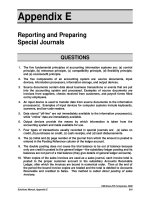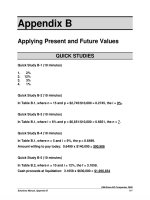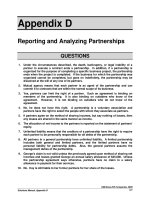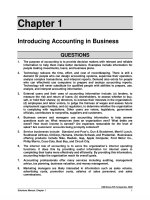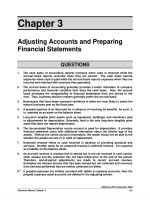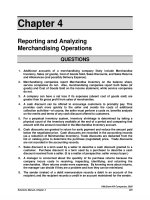Solution manual financial accounting 4e by wild appendix c
Bạn đang xem bản rút gọn của tài liệu. Xem và tải ngay bản đầy đủ của tài liệu tại đây (1.53 MB, 52 trang )
To download more slides, ebook, solutions and test bank, visit
Appendix C
Investments and International Operations
QUESTIONS
1.
To be classified as current assets, investments must be (i) capable of being
converted into cash quickly and (ii) management must intend to sell the investments
as a source of cash to satisfy the needs of current operations (within one year or the
operating cycle, whichever is longer).
2.
Short-term investments in trading securities are reported on the balance sheet at the
(fair) market value of the portfolio of trading securities.
3.
The $720 difference between the proceeds ($7,500) and the cost ($6,780) is credited
to Gain on Sale of Short-Term Investments and reported in the income statement.
4.
The three classes of noninfluential investments in securities are:
a) debt and equity trading securities.
b) debt securities held-to-maturity.
c) debt and equity securities available-for-sale.
The two classes of influential investments in securities are:
a) equity securities giving an investor a significant influence over an investee.
5.
6.
b) equity securities giving an investor control over an investee.
To be classified as current assets, investments must be capable of being converted
into cash quickly and management must intend to sell the investments as a source
of cash to satisfy the needs of current operations. To be classified as long-term,
investments must not meet the requirements for short-term investments—not
marketable and not intended to be converted into cash. Long-term investments also
include funds earmarked for a special purpose, and other assets not used in
company operations.
Unrealized lossEquity ...................................................... ##
Market Adjustment—Available-for-Sale (LT) ............
##
7.
The portfolio for investments in available-for-sale securities should be reported on
the balance sheet at (fair) market value—this is separated into short- and long-term.
8.
The portfolio of long-term investments in debt securities is reported at cost adjusted
for amortization of any difference between cost and maturity when the investments
are classified as held-to-maturity debt securities.
©McGraw-Hill Companies, 2008
Solutions Manual, Appendix C
725
To download more slides, ebook, solutions and test bank, visit
9.
Unrealized holding gains and losses are not reported on the standard income
statement for available-for-sale securities. Unrealized gains and losses for these
securities are reported in the stockholders’ equity section of the balance sheet.
(They can also be reported either in a separate comprehensive income statement or
in a combined statement of comprehensive income.)
10.
The equity method is used when the investor has a ―significant influence‖ over the
investee corporation; i.e., generally when the investor owns 20% or more of the
investee's voting stock. The equity method with consolidation is used when the
investor has a ―controlling influence‖ over the investee.
11.
A company prepares consolidated statements if the company has control over a
subsidiary as a result of owning more than 50% of the subsidiary's voting stock.
12A. Two major challenges in accounting for international operations include (1)
accounting for sales and purchases that are denominated in a foreign currency, and
(2) preparing consolidated financial statements with a foreign subsidiary.
13A. If the foreign exchange rate falls from $1.40 to $1.30 during the time the U.S.
company holds a receivable that is denominated in the foreign currency, the U.S.
company will incur an exchange loss. The foreign currency unit is worth $1.40 at the
time of sale but is worth only $1.30 at the time it is paid to the U.S. company; hence,
a loss of $0.10 is incurred for each foreign currency unit owed to the U.S. company.
14A. No. If a sales agreement requires a foreign customer to pay U.S. dollars to the
United States seller, the U.S. company is not exposed to the risk of exchange losses
or gains.
15.
Best Buy reported $59 million in foreign currency adjustments. This is an unrealized
gain.
16.
Circuit City’s financial statements, including its balance sheet, are all labeled as
being consolidated statements.
17.
Apple’s return on total assets as of September 25, 2004 is ($ millions):
$276/ [($8,050 + $6,815)/2] = 3.7%
QUICK STUDIES
Quick Study C-1 (10 minutes)
[Note: This actively managed (for profit) short-term investment in equity securities would
be classified as Trading Securities.]
Apr. 18 Short-Term Investments—Trading (XLT) ................... 12,850
Cash ...................................................................
12,850
Purchased 300 shares at $42 plus $250 fee.
May 30 Cash .........................................................................
Dividend Revenue ............................................
300
300
Received dividend of $1 per share.
©McGraw-Hill Companies, 2008
726
Financial Accounting, 4th Edition
To download more slides, ebook, solutions and test bank, visit
Quick Study C-2 (10 minutes)
1. 2008
Dec. 31 Unrealized Loss—Equity ..........................................
Market Adjustment—Available-for-Sale (ST) ...
3,000
3,000
To reflect an unrealized loss in market value
of the available-for-sale securities’ portfolio.
2. Both accounts in part (1) are reported on the balance sheet.
i. The Unrealized Loss is reported as a reduction in the equity section
(and in comprehensive income).
ii. The credit balance in the Market Adjustment—Available-for-Sale (ST)
account is a contra asset account. It reduces the (cost) balance in the
Short-Term Investments—Available-for-Sale account to its market
value.
3. 2009
Apr. 6
Cash ...........................................................................
Gain on Sale of Short-Term Investments ........
Short-Term Investments—AFS ........................
26,000
1,000
25,000
To record sale of one-half of the available-for-sale
securities. (Cost = $50,000 x 1/2)
Quick Study C-3 (10 minutes)
May 7 Short-Term Investments—AFS (Kraft) ....................... 10,300
Cash ...................................................................
10,300
Purchased 200 shares at $50 plus $300 fee.
June 6 Cash ......................................................................... 11,050
Gain on Sale of Short-Term Investments .......
Short-Term Investments—AFS (Kraft) ...........
750
10,300
To record sale of available-for-sale securities.
200 shares at $56 less $150 fee
©McGraw-Hill Companies, 2008
Solutions Manual, Appendix C
727
To download more slides, ebook, solutions and test bank, visit
Quick Study C-4 (10 minutes)
May 9 Short-Term Investments—AFS (Higo) ....................... 5,150
Cash ...................................................................
5,150
Purchased 200 shares at $25 plus $150 fee.
June 2 Cash* ....................................................................... 2,710
Gain on Sale of Short-Term Investments .......
Short-Term Investments—AFS (Higo) ............
135
2,575
To record sale of available-for-sale securities. The
original cost is $5,150 x 100/200 = $2,575
*($100 x $28) - $90
Dec. 31 Unrealized Loss – Equity* .........................................
Market Adjustment—Available-for-Sale (ST) ......
275
275
To reflect an unrealized loss in market value of
available-for-sale securities.
As of
Dec. 31
Number
of
Shares
Cost
per
share
Total
Cost
Market
Value per
share
Higo
100
$25.75
$2,575
$23
Total
Unrealized
Market
Loss
Value (Market-Cost)
$2,300
$275*
Quick Study C-5 (10 minutes)
True: b, d, f, g
Quick Study C-6 (10 minutes)
1. Interest revenue (or interest earned)
2. Equity method
3. Market value (or fair value)
4. Current (or short-term)
5. Parent, subsidiary
©McGraw-Hill Companies, 2008
728
Financial Accounting, 4th Edition
To download more slides, ebook, solutions and test bank, visit
Quick Study C-7 (10 minutes)
July 31
Cash ................................................................................
1,200
Interest Revenue ......................................................
1,200
Record interest earned ($40,000 x 6% x 6/12).
Dec. 31
Interest Receivable ........................................................
1,000
Interest Revenue ......................................................
1,000
Record interest earned ($1,200 x 5/6).
Quick Study C-8 (10 minutes)
Valuation Method: The (fair) market value method is used to account for this
investment in long-term equity securities (AFS portfolio).
2008
May 20
Long-Term Investments—AFS (ORD)..........................
1,000,000
Cash ..........................................................................
1,000,000
Record purchase of securities.
2009
Aug. 5
Cash ................................................................................
625,000
Long-Term Investments—AFS (ORD)* ..................
Gain on Sale of Long-Term Investment.................
500,000
125,000
Record sale of securities. *(½ x $1,000,000)
Quick Study C-9 (10 minutes)
a.
Nov. 1
Cash ...............................................................................
40,000
Long-Term Investment—ORD ................................
40,000
Received cash dividends ($100,000 x 40%).
b.
Dec. 31
Long-Term Investments—ORD ....................................
280,000
Earnings from Investment (ORD) ...........................
280,000
Record equity in investee earnings
($700,000 x 40%).
©McGraw-Hill Companies, 2008
Solutions Manual, Appendix C
729
To download more slides, ebook, solutions and test bank, visit
Quick Study C-10 (10 minutes)
1.
Dec. 31
12,000
Unrealized LossEquity ..............................................
Market Adjustment—Available-for-Sale (LT) .........
12,000
Record change in value of securities.
2. Each of the accounts used in the entry for (1) would be reported on the
balance sheet. The unrealized loss of $12,000 is a reduction in equity.
When the Market Adjustment account contains a credit balance as
shown here, it serves as a contra asset account. This results in the
reporting of the asset (long-term investment) at its market value.
Quick Study C-11 (10 minutes)
Return on total assets =
Net income
Average total assets
This ratio provides information to evaluate a company's profitability
(efficiency) in using its available assets.
Quick Study C-12 (10 minutes)
Return on Total Assets
=
Profit margin
Net income
Average total assets
=
Net income
Net sales
x Total asset turnover
x
Net sales
Average total assets
Component analysis is useful as it allows the determination of whether the
return on assets is achieved primarily due to profitability or efficiency of
asset usage (or a balanced combination of both). Component analysis
often is more useful when computed and examined over a period of several
years and when comparisons are made with competitors.
©McGraw-Hill Companies, 2008
730
Financial Accounting, 4th Edition
To download more slides, ebook, solutions and test bank, visit
Quick Study C-13A (10 minutes)
Date of Sale
Accounts Receivable ....................................................
14,500
Sales .........................................................................
14,500
Record credit sale in value of pounds
(10,000 pounds x 1.45).
Date of Payment
Cash ................................................................................
13,500
Foreign Exchange Loss ................................................
1,000
Accounts Receivable ..............................................
14,500
Cash received on account (£10,000 x 1.35).
Quick Study C-14A (10 minutes)
Mar. 1
Account Receivable—Hamac .......................................
9,076
Sales .........................................................................
9,076
Record credit sale in value of ringgits
(20,000 ringgits x $0.4538).
Mar. 31
Cash ................................................................................
9,798
Foreign Exchange Gain ..........................................
Accounts Receivable—Hamac ...............................
722
9,076
Cash received on account
(20,000 ringgits x $0.4899).
©McGraw-Hill Companies, 2008
Solutions Manual, Appendix C
731
To download more slides, ebook, solutions and test bank, visit
EXERCISES
Exercise C-1 (25 minutes)
a.
Feb. 15 Short-Term Investments—HTM (RTF) ...................... 120,000
Cash ..................................................................
120,000
Purchased 90-day, 8% debt securities.
b.
Mar. 22 Short-Term Investments—Trading (XIF) ............. 19,400
Cash ..................................................................
19,400
Purchased 700 shares of stock for
(700 x $27.50) + $150 brokerage fee.
c.
May 16 Cash ........................................................................ 122,400
Short-Term Investments—HTM (RTF) ...........
Interest Revenue .............................................
120,000
2,400
Collected proceeds of debt securities
with interest of $120,000 x .08 x 90/360.
d.
Aug. 1 Short-Term Investments—AFS (Flash Co.)......... 80,000
Cash ..................................................................
80,000
Purchased 6-month, 10% debt securities.
e.
Sept. 1 Cash ........................................................................
Dividend Revenue ...........................................
700
700
Received dividend on stock (700 x $1.00).
f.
Oct. 8 Cash* ...................................................................... 11,760
Short-Term Investments—Trading (XIF)** ......
Gain on Sale of Short-Term Investments ............
Sold 350 shares of stock.
* [(350 x $34) - $140] **($19,400/2)
g.
Oct. 30 Cash .............................................................................. 2,000
Interest Revenue ..............................................
9,700
2,060
2,000
Received cash interest payment
($80,000 x .10 x 90/360).
©McGraw-Hill Companies, 2008
732
Financial Accounting, 4th Edition
To download more slides, ebook, solutions and test bank, visit
Exercise C-2 (20 minutes)
1.
2008
Dec. 31 Market Adjustment—Trading ..............................
Unrealized Gain—Income ..............................
6,000
6,000
To reflect an unrealized gain in market values
of trading securities.
2. The accounts in part (1) are reported on different financial statements.
i. The $6,000 debit balance in the Market Adjustment—Trading account
is an adjunct asset account in the balance sheet. It increases the
balance of the Short-Term Investment—Trading account to the
securities’ market value of $72,000.
ii. The Unrealized Gain of $6,000 is reported in the Other Revenues and
Gains section of the income statement.
3.
2009
Jan. 3 Cash ....................................................................... 35,000
Gain on Sale of Short-Term Investments .....
Short-Term Investments—Trading ................
2,000
33,000
To record sale of trading securities.
Exercise C-3 (15 minutes)
Available-for-Sale Portfolio
Cost
Verrizano Corporation bonds payable .............. $ 89,600
Preble Corporation notes payable .....................
70,600
Lucerne Company common stock .....................
86,500
$246,700
Market
Unrealized
Gain (Loss)
$ 91,600
62,900
83,100
$237,600
$(9,100)
Dec. 31 Unrealized Loss—Equity.............................................. 9,100
Market Adjustment—AFS (ST) ........................
9,100
To reflect unrealized loss.
©McGraw-Hill Companies, 2008
Solutions Manual, Appendix C
733
To download more slides, ebook, solutions and test bank, visit
Exercise C-4 (30 minutes)
2008
(a) Feb. 15
Short-Term Investments—HTM (A.G.) ..............................
160,000
Cash .......................................................................... 160,000
Purchased 90-day, 10% notes.
(b) Mar. 22
Long-Term Investments—AFS (Fran) ...............................
35,850
Cash ..........................................................................
35,850
Purchased 700 shares of Fran common
stock ([700 x $51] + $150).
(c) May 15
Cash ................................................................................
164,000
Short-Term Investments—HTM (A.G.) ........................ 160,000
Interest Revenue ......................................................
4,000
Collected proceeds of 10% notes
($160,000 x 10% x 90/360).
(d) July 30
Short-Term Investments—Trading (MP3) ..........................
100,000
Cash .......................................................................... 100,000
Purchased 8% notes, due Jan. 30, 2009.
(e) Sept. 1
Cash ................................................................................
700
Dividend Revenue ...................................................
700
Received dividend on Fran shares
(700 x $1).
(f) Oct.
8
Cash*...............................................................................
22,275
Long-Term Investments—AFS (Fran)** ......................
Gain on Sale of L-T Investments ............................
17,925
4,350
Sold 350 shares of Fran stock.
*([350 x $64] - $125) **($35,850/2)
(g) Oct. 30
Cash ................................................................................
2,000
Interest Revenue ......................................................
2,000
Received interest payment on 8% notes
($100,000 x .08 x 3/12).
©McGraw-Hill Companies, 2008
734
Financial Accounting, 4th Edition
To download more slides, ebook, solutions and test bank, visit
Exercise C-5 (15 minutes)
Computation of Market Adjustment
Cost
Market
Value
Nintendo Co. common stock ........................................
$ 44,450 $ 48,900
Atlantic Richfield Co. bonds payable ..........................
49,000
47,000
Kellogg Company notes payable .................................
25,000
23,200
McDonald's Corp. common stock ................................
46,300
44,800
$164,750 $163,900
Dec. 31
Unrealized
Gain (Loss)
$ (850)
Unrealized Loss—Equity .............................................. 850
Market Adjustment—AFS (ST) ...............................
850
Record market value adjustment for securities.
Exercise C-6 (15 minutes)
Dec. 31
Market Adjustment—AFS (LT) ......................................8,562
Unrealized Loss—Equity ........................................
Unrealized Gain—Equity .........................................
7,562
1,000
Record market (fair) value of AFS securities.
Computation of Market Adjustment
12/31/2007
12/31/2008
Cost ...............................
$87,855
$89,980
Market value ..................80,293
90,980
Gain (loss) .....................
$ (7,562)
$ 1,000
Adjustment = $7,562 + $1,000 = $8,562
(recovery of unrealized loss &
recording of unrealized gain)
©McGraw-Hill Companies, 2008
Solutions Manual, Appendix C
735
To download more slides, ebook, solutions and test bank, visit
Exercise C-7 (30 minutes)
2006
Dec. 31
Unrealized Loss—Equity ..............................................
11,140
Market Adjustment—AFS (LT) ................................
11,140
Record market value of securities
($372,000 - $360,860).
2007
Dec. 31
Market Adjustment—AFS (LT)* ....................................
38,440
Unrealized Loss—Equity ........................................
Unrealized Gain—Equity .........................................
11,140
27,300
Record market value of securities.
* $428,500 - $455,800 = $27,300 net gain
($11,140 prior loss + $27,300 current period gain).
2008
Dec. 31
Market Adjustment—AFS (LT)* ....................................
73,000
Unrealized Gain—Equity .........................................
73,000
Record market value of securities.
* $600,200 - $700,500 = $100,300 net gain
($100,300 current period gain - $27,300 prior gain).
2009
Dec. 31
Unrealized Loss—Equity ..............................................
96,700
Unrealized Gain—Equity ...............................................
100,300
Market Adjustment—AFS (LT)* .............................
197,000
Record market value of securities.
* $876,900 - $780,200 = $96,700 net loss
($100,300 prior gain + $96,700 current period loss).
©McGraw-Hill Companies, 2008
736
Financial Accounting, 4th Edition
To download more slides, ebook, solutions and test bank, visit
Exercise C-8 (15 minutes)
1. Classification of Investments in Securities
a. The Beeman Company bonds are a long-term investment in held-tomaturity debt securities.
b. The Baybridge stock is a long-term investment in equity securities
where the investor has a significant influence over the investee.
c. The Carroll stock is a long-term investment in available-for-sale equity
securities.
d. The Newtech stock is a long-term investment in available-for-sale
equity securities.
e. Since the Flock stock is marketable and is held as an investment of
cash available for operations, it is a current asset.
2. Market Adjustment entry at December 31, 2008
Dec. 31 Market Adjustment—AFS (LT) ......................................
10,825
Unrealized GainEquity .........................................
10,825
Record market value of securities ($255,800 - $266,625).
Long-term AFS securities
Cost
Market Value
Carroll common stock ...............................
$165,500
$178,000
Newtech common stock ...........................
90,300
88,625
Totals ..........................................................
$255,800
$266,625
©McGraw-Hill Companies, 2008
Solutions Manual, Appendix C
737
To download more slides, ebook, solutions and test bank, visit
Exercise C-9 (30 minutes)
2008
Jan. 2
Long-Term Investments—Goreten* .................................
411,000
Cash ..........................................................................
411,000
Record purchase of investment ($408,000 + $3,000).
* Kodan’s investment equals 33 1/3% of Goreten’s stock (30,000/90,000).
Kodan should use the equity method to account for its investment.
Sept. 1
Cash ................................................................................
45,000
Long-Term Investments—Goreten ............................
45,000
Record receipt of cash dividend (30,000 x $1.50).
Dec. 31
Long-Term Investments—Goreten ..................................
162,300
Earnings from Long-Term Investment ..................
162,300
Record equity in investee earnings ($486,900/3).
2009
June 1
Cash ................................................................................
63,000
Long-Term Investments—Goreten ............................
63,000
Record receipt of cash dividend (30,000 x $2.10).
Dec. 31
Long-Term Investments—Goreten ..................................
234,250
Earnings from Long-Term Investment ..................
234,250
Record equity in investee earnings ($702,750/3).
Dec. 31
Cash ................................................................................
320,000
Gain on Sale of Investments ..................................
86,817
Long-Term Investments—Goreten* ...........................
233,183
Record sale of investment.
* Book value (Goreten stock) at 12/31/2009:
Original cost ....................................................................................
$411,000
Less 2008 dividends .......................................................................
(45,000)
Plus share of 2008 earnings ...........................................................
162,300
Less 2009 dividends .......................................................................
(63,000)
Plus share of 2009 earnings ...........................................................
234,250
Book value at date of sale ..............................................................
$699,550
Book value of shares sold ($699,550 x [10,000/30,000]) ..................
$233,183†
†
Rounded to nearest dollar.
©McGraw-Hill Companies, 2008
738
Financial Accounting, 4th Edition
To download more slides, ebook, solutions and test bank, visit
Exercise C-10 (15 minutes)
2008 return on total assets
$38,400
($210,000 + $340,000)/2
2009 return on total assets
= 14.0%
$60,300
= 10.9%
($340,000 + $770,000)/2
Regae Industries appears to be less efficient in the use of its total assets in
2009 than in 2008 as suggested by the decline in return on total assets
from 14.0% to 10.9%. However, without additional information, it is not
possible to determine whether Regae is within the normal range as
compared to similar companies. In addition, conditions may exist that
explain the apparent decline in efficiency between 2008 and 2009. For
example, Regae may have increased its investment in plant assets in 2009
in anticipation of increased production and sales in 2010.
Or, its
competitors’ returns may have fallen even more than that of Regae’s
returns.
Exercise C-11A (25 minutes)
2008
Dec. 16
24,791
Accounts ReceivableBronson Ltd. ..........................
Sales .........................................................................
24,791
Record credit sales (17,000 x $1.4583).
Dec. 31
Foreign Exchange Loss* ...............................................
342
Accounts ReceivableBronson Ltd .....................
342
Record year-end adjustment.
*Original measure = (17,000 x $1.4583)
Year-end measure = (17,000 x $1.4382)
Loss for the period
2009
Jan. 15
=
=
=
$24,791
24,449
$ 342
Cash (17,000 x $1.4482) ................................................
24,619
Accounts ReceivableBronson Ltd. ....................
Foreign Exchange Gain* .........................................
24,449
170
Record cash receipt on account.
*Year-end measure = (17,000 x $1.4382)
Final measure = (17,000 x $1.4482)
Gain for the period
=
=
=
$24,449
24,619
$ 170
©McGraw-Hill Companies, 2008
Solutions Manual, Appendix C
739
To download more slides, ebook, solutions and test bank, visit
Exercise C-12A (25 minutes)
Quarter ended June 30, 2008
May 8 recorded amount (800,000 x $0.1323) ......................
June 30 balance sheet amount (800,000 x $0.1352)...........
Unrealized gain reported on income statement ................
$105,840
108,160
$ 2,320
Quarter ended September 30, 2008
June 30 balance sheet amount ............................................
Sept. 30 balance sheet amount (800,000 x $0.1368) ..........
Unrealized gain reported on income statement .................
$108,160
109,440
$ 1,280
Quarter ended December 31, 2008
Sept. 30 balance sheet amount ............................................
Dec. 31 balance sheet amount (800,000 x $0.1335) ...........
Unrealized loss reported on income statement .................
$109,440
106,800
$ 2,640
Quarter ended March 31, 2009
Dec. 31 balance sheet amount ............................................
Feb. 10, 2009, amount received (800,000 x $0.1386) .........
Realized gain reported on income statement .....................
$106,800
110,880
$ 4,080
Note — The combined net gain for all four quarters equals:
$5,040 ($2,320 + $1,280 - $2,640 + $4,080).
This amount also equals the difference between the number of dollars finally
received ($110,880) and the initial measure of the account receivable ($105,840).
In addition, this amount equals the number of pesos (800,000) owed by the
customer times the change in the exchange rate ($0.0063) between the beginning
rate ($0.1323) and the ending rate ($0.1386).
©McGraw-Hill Companies, 2008
740
Financial Accounting, 4th Edition
To download more slides, ebook, solutions and test bank, visit
PROBLEM SET A
Problem C-1A (60 minutes)
Part 1
2008
Jan. 20 Short-Term Investments—Trading (Ford) ................
Cash ................................................................
20,925
20,925
Purchased Ford Motor Co.
shares [(800 x $26.00) + $125].
Feb. 9 Short-Term Investments—Trading (Lucent) ......
Cash ................................................................
97,928
97,928
Purchased Lucent shares
[(2,200 x $44.25) + $578].
Oct. 12 Short-Term Investments—Trading (Z-Seven) .....
Cash ................................................................
5,825
5,825
Purchased Z-Seven shares
[(750 x $7.50) + $200].
2009
Apr. 15 Cash ......................................................................
Gain on Sale of Short-Term Investments ....
Short-Term Investments—Trading (Ford) .....
22,915
1,990
20,925
Sold Ford Motor shares
[(800 x $29.00) - $285].
July 5 Cash ......................................................................
Gain on Sale of Short-Term Investments ....
Short-Term Investments—Trading (Z-Seven) ...
7,585
1,760
5,825
Sold Z-Seven shares
[(750 x $10.25) - $102.50].
22 Short-Term Investments—Trading (Hunt) ...........
Cash ................................................................
48,444
48,444
Purchased Hunt shares
[(1,600 x $30.00) + $444].
Aug. 19 Short-Term Investments—Trading (D.Karan)......
Cash ................................................................
33,140
33,140
Purchased Donna Karan shares
[(1,800 x $18.25) + $290].
©McGraw-Hill Companies, 2008
Solutions Manual, Appendix C
741
To download more slides, ebook, solutions and test bank, visit
Problem C-1A (Concluded)
2010
Feb. 27 Short-Term Investments—Trading (HCA) ................ 116,020
Cash ................................................................
116,020
Purchased HCA shares
[(3,400 x $34.00) + $420].
Mar. 3 Cash ......................................................................
Loss on Sale of Short-Term Investments ................
Short-Term Investments—Trading (Hunt) .....
Sold Hunt shares [(1,600 x $25.00) - $250].
June 21 Cash ......................................................................
Loss on Sale of Short-Term Investments .........
Short-Term Investments—Trading (Lucent) ....
39,750
8,694
48,444
91,980
5,948
97,928
Sold Lucent shares [(2,200 x $42.00) - $420].
30 Short-Term Investments—Trading (B&D) ...........
Cash ................................................................
57,595
57,595
Purchased Black & Decker shares
[(1,200 x $47.50) + $595].
Nov. 1 Cash ......................................................................
Loss on Sale of Short-Term Investments .........
Short-Term Investments—Trading (D.Karan)....
32,541
599
33,140
Sold Donna Karan shares
[(1,800 x $18.25) - $309].
Part 2 (Adjusting entry at Dec. 31, 2010)
Dec. 31 Market Adjustment—Trading*....................................
Unrealized Gain—Income ....................................
To reflect an unrealized gain in market values
of trading securities.
985
985
* Market adjustment computations
Trading securities’
Share Price Market
Unrealized
portfolio
Shares at 12/31/07
Value
Cost
Gain (Loss)
HCA .................................
3,400
$36.00
$122,400 $116,020
$ 6,380
Black and Decker ..............
1,200
$43.50
52,200
57,595
(5,395)
Totals...............................
$174,600 $173,615
$ 985
©McGraw-Hill Companies, 2008
742
Financial Accounting, 4th Edition
To download more slides, ebook, solutions and test bank, visit
Problem C-2A (40 minutes)
Part 1
2008
Apr. 16 Short-Term Investments—AFS (Gem) .........................
97,180
Cash ...............................................................................
97,180
Purchased 4,000 shares of Gem
[(4,000 x $24.25) + $180].
May. 1 Short-Term Investments—AFS (T-bills) .......................
100,000
Cash .........................................................................
100,000
Purchased U.S. Treasury bills.
July 7 Short-Term Investments—AFS (Pepsi) ........................
98,675
Cash .........................................................................
98,675
Purchased 2,000 shares of PepsiCo
[(2,000 x $49.25) + $175].
20 Short-Term Investments—AFS (Xerox)........................
16,955
Cash .........................................................................
16,955
Purchased 1,000 shares of Xerox
[(1,000 x $16.75) + $205].
Aug. 3 Cash ...............................................................................
101,500
Short-Term Investments—AFS (T-bills) .................
Interest Revenue ..........................................................
100,000
1,500
Proceeds of U.S. Treasury bills
($100,000 x .06 x 3/12).
15 Cash .....................................................................................
3,400
Dividend Revenue ..................................................
3,400
Received dividends on Gem (4,000 x $0.85).
28 Cash*....................................................................................
59,775
Short-Term Investments—AFS (Gem)** .................
Gain on Sale of Short-Term Investments .............
48,590
11,185
Sold 2,000 shares of Gem.
*(2,000 x $30) - $225 **($97,180 x 2,000/4,000)
Oct. 1 Cash .............................................................................. 3,800
Dividend Revenue ............................................
3,800
Received dividends on PepsiCo (2,000 x $1.90).
Dec. 15 Cash ......................................................................... 2,100
Dividend Revenue ............................................
2,100
Received dividends on Gem (2,000 x $1.05).
31 Cash ......................................................................... 2,600
Dividend Revenue ............................................
2,600
Received dividends on PepsiCo (2,000 x $1.30).
©McGraw-Hill Companies, 2008
Solutions Manual, Appendix C
743
To download more slides, ebook, solutions and test bank, visit
Problem C-2A (Continued)
Part 2
Comparison of Cost and Market Values for AFS Portfolio
Gem Co.
PepsiCo
Xerox
a
b
c
Cost
a
(2,000 x $24.25) + 90 ............... $ 48,590
2,000 x $26.50 .........................
(2,000 x $49.25) + 175b.............
98,675
2,000 x $46.50 .........................
(1,000 x $16.75) + 205c .............
16,955
1,000 x $13.75 .........................
$164,220
Market
Unrealized
Gain (Loss)
$ 53,000
93,000
13,750
$159,750
$(4,470)
Brokerage fee attached to remaining 2,000 shares: $180 x (4,000 sh –2,000 sh.)/ 4,000 sh.= $90.
Brokerage fee attached to remaining 4,000 shares: Entire $175 (none sold).
Brokerage fee attached to remaining 2,000 shares: Entire $205 (none sold).
Part 3
Dec. 31 Unrealized LossEquity ................................................ 4,470
Market Adjustment—AFS (ST) ...........................
4,470
To reflect an unrealized loss in market values of
available-for-sale securities.
Part 4
The balance sheet would report the cost of these short-term investments in
available-for-sale securities at $164,220 and show a subtraction of $4,470
for the market adjustment. This yields $159,750 as the net market value for
these securities reported in the current assets section. An alternative
presentation is to list these securities at the market value of $159,750 with
a note disclosure of the cost.
Part 5
(a)
Income statement
(i) Interest Revenue, $1,500
(ii) Dividend Revenue, $11,900 [$3,400 + $3,800 + $2,100 + $2,600]
(iii) Gain on Sale of Short-Term Investments, $11,185
(iv) Net effect on income is $24,585
(b)
Equity section of Balance sheet
(i) Subtraction from equity due to the Unrealized Loss, $4,470
(ii) Increase to equity from the $24,585 increase in income
(iii) Net effect on equity is $20,115
©McGraw-Hill Companies, 2008
744
Financial Accounting, 4th Edition
To download more slides, ebook, solutions and test bank, visit
Problem C-3A (50 minutes)
Part 1
2008
Jan. 20
Long-Term Investments—AFS (J&J) .............................
20,740
Cash ..........................................................................
20,740
Purchased Johnson & Johnson
shares [(1,000 x $20.50) + $240].
Feb.
9
Long-Term Investments—AFS (Sony) ............................
55,665
Cash ..........................................................................
55,665
Purchased Sony shares
[(1,200 x $46.20) + $225].
June 12
Long-Term Investments—AFS (Mattel) ....................................
40,695
Cash .................................................................................... 40,695
Purchased Mattel shares
[(1,500 x $27.00) + $195].
Dec. 31
Unrealized LossEquity ..............................................3,650
Market Adjustment—AFS (LT)* ................................
3,650
Annual adjustment to market values.
*
Cost
J & J .................. $ 20,740
Sony ..................
55,665
Mattel ................
40,695
Total .................. $117,100
Market
$ 21,500
45,600
46,350
$113,450
J & J: 1,000 x $21.50 = $21,500
Sony: 1,200 x $38.00 = $45,600
Mattel: 1,500 x $30.90 = $46,350
Mkt. Adj.: $117,100 - $113,450 = $3,650
©McGraw-Hill Companies, 2008
Solutions Manual, Appendix C
745
To download more slides, ebook, solutions and test bank, visit
Problem C-3A (Continued)
2009
Apr. 15
Cash ..........................................................................................
22,975
Gain on Sale of Investments ............................................ 2,235
Long-Term Investments—AFS (J&J) ................................. 20,740
Sold Johnson & Johnson shares
[(1,000 x $23.50) - $525].
July
5
Cash ..........................................................................................
35,615
Loss on Sale of Investments ..................................................
5,080
Long-Term Investments—AFS (Mattel) .............................. 40,695
Sold Mattel shares [(1,500 x $23.90) - $235].
July 22
Long-Term Investments—AFS (Sara Lee) .................................
13,980
Cash .................................................................................... 13,980
Purchased Sara Lee shares
[(600 x $22.50) + $480].
Aug. 19
Long-Term Investments—AFS (Eastman Kodak) .......................
15,498
Cash .................................................................................... 15,498
Purchased Eastman Kodak shares
[(900 x $17.00) + $198].
Dec. 31
10,168
Unrealized LossEquity ........................................................
Market Adjustment—AFS (LT)* ........................................... 10,168
Annual adjustment to market values.
*
Cost
Kodak ................... $15,498
Sara Lee ............... 13,980
Sony ..................... 55,665
Total ..................... $85,143
Market
$17,325
12,000
42,000
$71,325
Kodak:
900 x $19.25 = $17,325
Sara Lee:
600 x $20.00 = $12,000
Sony:
1,200 x $35.00 = $42,000
$85,143 - $71,325 = $13,818
Market Adjustment account:
Required balance ..... $13,818 Cr.
Unadjusted balance.. 3,650 Cr.
Required change...… $10,168 Cr.
©McGraw-Hill Companies, 2008
746
Financial Accounting, 4th Edition
To download more slides, ebook, solutions and test bank, visit
Problem C-3A (Continued)
2010
Feb. 27
Long-Term Investments—AFS (Microsoft) ................................
161,325
Cash ...................................................................................161,325
Purchased Microsoft shares
[(2,400 x $67.00) + $525].
June 21
Cash .........................................................................................
56,720
Gain on Sale of Investments ............................................ 1,055
Long-Term Investments—AFS (Sony) ............................... 55,665
Sold Sony shares [(1,200 x $48.00) - $880].
June 30
Long-Term Investments—AFS (Black & Decker) ........................
50,835
Cash ................................................................................... 50,835
Purchased Black & Decker shares
[(1,400 x $36.00) + $435].
Aug. 3
Cash .........................................................................................
9,315
Loss on Sale of Investments .................................................
4,665
Long-Term Investments—AFS (Sara Lee)........................... 13,980
Sold Sara Lee shares
[(600 x $16.25) - $435].
Nov. 1
Cash .........................................................................................
19,850
Gain on Sale of Investments ........................................... 4,352
Long-Term Investments—AFS (E. Kodak) .......................... 15,498
Sold Eastman Kodak shares
[(900 x $22.75) - $625].
Dec. 31
Market Adjustment—AFS (LT)* ................................................
21,858
Unrealized Loss—Equity .................................................. 13,818
Unrealized Gain—Equity ................................................... 8,040
Annual adjustment to market values.
*
Cost
Black & Decker ................. $ 50,835
Microsoft ...........................
161,325
Total................................... $212,160
Market
$ 54,600
165,600
$220,200
Black & Decker: 1,400 x $39.00 = $ 54,600
Microsoft:
2,400 x $69.00 = $165,600
$212,160 - $220,200 = $8,040 (market exceeds cost)
Market Adjustment account:
Required balance ............ $ 8,040 Dr.
Unadjusted balance......... 13,818 Cr.
Required change ............. $21,858 Dr.
©McGraw-Hill Companies, 2008
Solutions Manual, Appendix C
747
To download more slides, ebook, solutions and test bank, visit
Problem C-3A (Concluded)
Part 2
12/31/2008 12/31/2009 12/31/2010
Long-Term AFS Securities (cost)................... $117,100
$85,143
$212,160
Market Adjustment .....................................
(3,650)
(13,818)
8,040
Long-Term AFS Securities (market) .............. $113,450
$71,325
$220,200
Part 3
2008
2009
2010
Realized gains (losses)
Sale of Johnson & Johnson shares .......
Sale of Mattel shares................................
Sale of Sara Lee shares ...........................
Sale of Sony shares .................................
Sale of Eastman Kodak shares ............... ______
Total realized gain (loss) ........................... $
0
$ 2,235
(5,080)
_______
$ (2,845)
$(4,665)
1,055
4,352
$ 742
Unrealized gains (losses) at year-end*..... $(3,650)
$(13,818)
$ 8,040
* Equals the balance of the Market Adjustment account.
©McGraw-Hill Companies, 2008
748
Financial Accounting, 4th Edition
To download more slides, ebook, solutions and test bank, visit
Problem C-4A (40 minutes)
Part 1
Available-for-sale securities on December 31, 2008
Security
Cost
3,500 shares of Company B common stock ..............
$ 79,690
17,500 shares of Company C common stock ..............662,750
4,500 shares of Company X common stock ..............128,312
8,500 shares of Company Z common stock ..............270,350
$1,141,102
Market Value
$ 81,375
610,312
118,125
278,800
$1,088,612
Disclosure
The portfolio of available-for-sale securities would be reported on the
December 31, 2008, balance sheet at its market value of $1,088,612.
Part 2
Dec. 31
Market Adjustment—AFS* ......................................................
20,002
Unrealized Loss—Equity ................................................. 20,002
Adjustment to market for AFS securities..
* December 31, 2007, available-for-sale securities
Cost
Market Value
$ 535,300
$ 490,000
159,380
154,000
662,750
640,938
$1,357,430
$1,284,938
December 31, 2008, adjustment to the Market Adjustment account:
$1,357,430 - $1,284,938 = $ 72,492 Cr. balance on Dec. 31, 2007
$1,141,102 - $1,088,612 =
52,490 Cr. balance required on Dec. 31, 2008
$ 20,002 Dr. to adjust cost to market value
Part 3
Only gains or losses realized on the sale of available-for-sale securities
appear on the 2008 income statement. Unrealized gains or losses appear
in the equity section of the balance sheet.
Year 2008 realized gains (losses)
Stock Sold
Cost
3,500 shares of Company B stock ............ $ 79,690
40,000 shares of Company A stock .......... 535,300
Realized gain (loss) ...................................
Sale
Gain (Loss)
$ 77,688 $ (2,002)
510,900
(24,400)
$(26,402)
©McGraw-Hill Companies, 2008
Solutions Manual, Appendix C
749


